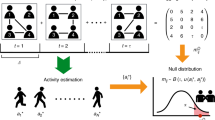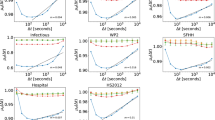Abstract
Temporal relational events are evidence of dynamically evolving social networks. The timing of the creation and dissolving of enduring ties, such as friendships or alliances, often depend on a large variety of factors. Particularly, the presence of the so-called triadic or transitive effects suggests a certain maturity of the underlying social process and is an important feature of various social relationships. Various models have been proposed to capture various determinants of such temporal relational events. The main obstacle for widely using these models in practice is their computational complexity, especially for modern, online recorded data. The aim of this paper is to propose a simple test for the presence of triadic effects in relational event data. We propose a joint test for triadic closure and triadic protection of ties, based on a combination of a method-of-moments estimator and a Hotelling’s T2 test. Such test is computationally fast and statistically near-efficient, and we show how the test is particularly insightful for the analysis of two studies involving relational event data.








Similar content being viewed by others
Notes
We used the data set “alliances” from the xergm.common package in R.
Data set is freely available at http://www.sociopatterns.org/datasets/sfhh-conference-data-set/
References
Ang CS (2011) Interaction networks and patterns of guild community in massively multiplayer online games. Soc Netw Anal Min 1:341–353
Barabási AL, Albert R (1999) Emergence of scaling in random networks. Science 286(5439):509–512
Barabsi AL, Ravasz E, Oltvai Z (2003) Hierarchical organization of modularity in complex networks. Stat Mech Complex Netw 625:46–65
Benson A, Gleich DF, Leskovec J (2016) Higher-order organization of complex networks. Science 353(6295):163–166
Benson AR, Abebe R, Schaub MT, Jadbabaie A, Kleinberg J (2018) Simplicial closure and higher-order link prediction. Proc Natl Acad Sci USA 115(48):E11221–E11230
Berge C (1989) Hypergraphs—combinatorics of finite sets. North-Holland mathematical library, vol 45. North-Holland
Bianconi G, Barabási AL (2001) Competition and multiscaling in evolving networks. Europhys Lett (EPL) 54(4):436–442
Bianconi G, Darst RK, Iacovacci J, Fortunato S (2014) Triadic closure as a basic generating mechanism of communities in complex networks. Phys Rev E 90:042806. https://doi.org/10.1103/PhysRevE.90.042806
Blundell C, Heller K, Beck J (2012) Modelling reciprocating relationships with hawkes processes. Adv Neural Inf Process Syst 25(15):5249–5262
Burt RS (1982) Toward a structural theory of action. Academic Press, New York
Burt RS (1992) Structural holes: the social structure of competition. Harvard University Press, Cambridge, MA
Butts CT (2008) A relational event framework for social action. Sociol Methodol 38(1):155–200
Callaway DS, Hopcroft JE, Kleinberg J, Newman MEJ, Strogatz SH (2001) Are randomly grown graphs really random? Physical Review E 64:041902. https://doi.org/10.1103/PhysRevE.64.041902
Clauset A, Moore C, Newman MEJ (2008) Hierarchical structure and the prediction of missing links in networks. Nature 453:98–101
Coleman JS (1988) Social capital in the creation of human capital. Am J Sociol 94:S95–S120
Cranmer SJ, Desmarais BA, Kirkland JH (2012a) Toward a network theory of alliance formation. Int Interact 38(3):295–324
Cranmer SJ, Desmarais BA, Kirkland JH, Menninga EJ (2012b) Complex dependencies in the alliance network. Int Interact 29(3):279–313
Davidsen J, Ebel H, Bornholdt S (2002) Emergence of a small world from local interactions: modeling acquaintance networks. Phys. Rev. Lett 88(12):128701. https://doi.org/10.1103/PhysRevLett.88.128701
Davis JA (1970) Clustering and hierarchy in interpersonal relations: testing two graph theoretical models on 742 sociomatrices. Am Sociol Rev 35:843–851
Davis JA, Leinhardt S (1967) The Structure of Positive Interpersonal Relations in Small Groups. Houghton Mifflin
Dubois C, Butts C, Smyth P (2013) Stochastic blockmodeling of relational event dynamics. In: Artificial intelligence and statistics, pp 238–246
Eder D, Hallinan MT (1978) Sex differences in children’s friendships. Am Sociol Rev 43:237–250
Ehrhardt G, Marsili M, V.R F (2006) Phenomenological models of socioeconomic network dynamics. Phys Rev E 74:1–11
Feld SL (1981) The focused organization of social ties. Am J Sociol 86:1015–1035
Foster DV, Foster JG, Grassberger P, Paczuski M (2011) Clustering drives assortativity and community structure in ensembles of networks. Phys Rev E 84:066117. https://doi.org/10.1103/PhysRevE.84.066117
Frankl P (1995) Extremal set systems. Handb Comb 2:1293–1330
Génois M, Barrat A (2018) Can co-location be used as a proxy for face-to-face contacts? EPJ Data Sci 7(1):2–17
Gould RV, Fernandez RM (1989) Structures of mediation: a formal approach to brokerage in transaction networks. Sociol Methodol 19:89–126
Grindrod P, Higham DJ, Parsons MC (2012) Bistability through triadic closure. Internet Math 8(4):402–423
Hatcher A (2002) Algebraic topology. Cambridge University Press, Cambridge, UK
Holland PW, Leinhardt S (1978) An omnibus test for social structure using triads. Sociol Methods Res 7:227–256
Holme P (2015) Modern temporal network theory: a colloquium. Eur Phys J B Condens Matter Complex Syst 88(9):1–30
Holme P, Saramäki J (2012) Temporal networks. Phys Rep 519(3):97–125
Iacopini I, Petri G, Barrat A, Latora V (2019) Simplicial models of social contagion. Nat Commun 10:2485
Kas M, Carley K, Carley R (2012) Trends in science networks: understanding structures and statistics of scientific networks. Soc Netw Anal Min 2:169–187
Kovanen L, Karsai M, Kaski K, Kertész J, Saramki J (2011) Temporal motifs in time-dependent networks. J Stat Mech Theory Exp 2011(11):2–18
Krackhardt D (1994) Graph theoretical dimensions of informal organizations. Lawrence Erlbaum Associates, p 89112
Krivitsky PN, Handcock MS (2014) A separable model for dynamic networks. J R Stat Soc Ser B 76(1):29–46
Kumpula JM, Onnela JP, Saramäki J, Kaski K, Kertész J (2007) Emergence of communities in weighted networks. Phys Rev Lett 99:228701. https://doi.org/10.1103/PhysRevLett.99.228701
Kunegis J, Blattner M, Moser C (2013) Preferential attachment in online networks: Measurement and explanations. In: Proceedings of the 5th annual ACM web science conference (WebSci ’13), pp 205–214
Leskovec J, Backstrom L, Kumar R, Tomkins A (2008) Microscopic evolution of social networks. In: Proceedings of the 14th ACM SIGKDD international conference on knowledge discovery and data mining (KDD ’08). ACM, New York, NY, USA, pp 462–470
Mantzaris AV, Higham DJ (2013) Infering and calibrating triadic closure in a dynamic network. Springer, Berlin, pp 265–282
Marsili M, Vega-Redondo F, Slanina F (2004) The rise and fall of a networked society: a formal model. Proc Natl Acad Sci USA 101(6):1439–1442
McPherson M, Smith-Lovin L, Cook JM (2001) Birds of a feather: homophily in social networks. Annu Rev Sociol 27:415–444
Mislove A, Koppula HS, Gummadi KP, Druschel P, Bhattacharjee B (2008) Growth of the flickr social network. In: Proceedings of the first workshop on online social networks (WOSN ’08). ACM, New York, NY, USA, pp 25–30
Newman MEJ (2001) Clustering and preferential attachment in growing networks. Phys Rev E 64:025102. https://doi.org/10.1103/PhysRevE.64.025102
Newman M, Watts D, Strogatz S (2002) Random graph models of social networks. Proc Natl Acad Sci USA 99:2566–2572
Newman MEJ, Park J (2003) Why social networks are different from other types of networks. Phys Rev E 68:036122. https://doi.org/10.1103/PhysRevE.68.036122
Overgoor J, Benson AR, Ugander J (2018) Choosing to grow a graph: modeling network formation as discrete choice. CoRR arXiv:abs/1811.05008
Paranjape A, Benson AR, Leskovec J (2017) Motifs in temporal networks. In: Proceedings of the 10th ACM international conference on web search and data mining, pp 601–610
Ross SM (2006) Introduction to probability models, 9th edn. Academic Press Inc, Orlando, FL, USA
Scholz C, Atzmueller M, Stumme G (2014) Predictability of evolving contacts and triadic closure in human face-to-face proximity networks. Soc Netw Anal Min. https://doi.org/10.1007/s13278-014-0217-1
Simmel G, Wolff KH (1950) The sociology of Georg Simmel. Free Press, Illinois
Snijders TAB (1996) Stochastic actor-oriented models for network change. J Math Sociol 21(12):149–172
Snijders TAB (2001) The statistical evaluation of social network dynamics. Sociol Methodol 31:361–395
Tuma NB, Hallinan MT (1979) The effects of sex, race and achievement on schoolchildrens friendships. Soc Forces 57:1265–1285
Watts DJ, Strogatz SH (1998) Collective dynamics of ’small-world’ networks. Nature 393(6684):440–442
Xu J, Wickramarathne T, Chawla N (2016) Representing higher order dependencies in networks. Comput Res Repos 2(5):e1600028. https://doi.org/10.1126/sciadv.1600028
Acknowledgements
This work was supported by a STSM Grant from COST Action COSTNET CA15109.
Author information
Authors and Affiliations
Corresponding author
Additional information
Publisher's Note
Springer Nature remains neutral with regard to jurisdictional claims in published maps and institutional affiliations.
Appendices
Appendices
1.1 Starting values for Newton–Raphson
Suppose that \(\varDelta t\) is the time interval between two observations. Then, the probability that links disappear during time \(\varDelta t\) is given by
The empirical probability can be expressed as the ratio between the number of extinguished links (\(s_{10}\)) and the total number of links (\(s_1\)):
By equating the empirical and theoretical probability, we obtain a rough estimate for parameter \(\mu\)
Respectively, we can show that
where \(s_{01}\) denotes the number of appeared links and \(s_0\) the total number of non-links.
Rights and permissions
About this article
Cite this article
Užupytė, R., Wit, E.C. Test for triadic closure and triadic protection in temporal relational event data. Soc. Netw. Anal. Min. 10, 21 (2020). https://doi.org/10.1007/s13278-020-0632-4
Received:
Revised:
Accepted:
Published:
DOI: https://doi.org/10.1007/s13278-020-0632-4




